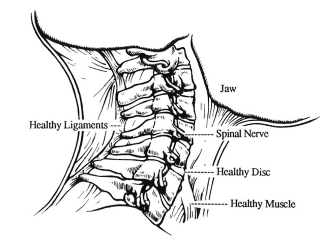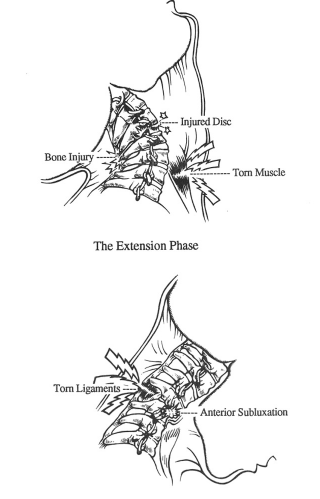The soft tissues of the cervical spine (neck) are the most commonly injured tissues in whiplash trauma. The muscles, tendons, Ligaments, and cartilage that surround the neck region can be over-stretched and torn to a variety of degrees. To fully understand this point it is necessary to understand what a normal—uninjured neck is like.
Drawing of a normal neck. Note the smooth, uninterrupted C-shaped curve formed by the seventh cervical vertebrae (bones of the spine).

The alignment of these bones is critical to the function of the cervical spine and the health of the entire body. The discs are the tissues between each vertebra that act as a shock absorber and allow motion between segments. When uninjured, the discs of the human body will usually last a lifetime. Note how the spinal nerves exit from pathways between the vertebrae and come in close proximity to the discs. These nerves carry messages to and from the body and the brain. Thus, any problem with vertebral alignment or disc function can have a dramatic effect on the nerves, affecting the body and mind
Holding these structures together are the ligaments, muscles, tendons, and other connective tissues. Ligaments are the prime stabilizers of this region and prevent excessive motion between the vertebrae. Since ligaments have a poor blood supply they heal poorly when injured. The muscles, by contrast, have an excellent blood supply and heal more rapidly than ligaments. However, the muscles of the neck and upper back, when whiplashed, often heal with a type of scar tissue that causes many secondary problems, prolonging recovery.
Drawing of a neck recently injured in a whiplash.

Not all necks are injured to such an extent but this drawing shows many of the common effects of a whiplash injury. Note that the gentle C-shaped curve of the normal next has been dramatically altered. The upper half of the curve is now straightened due to muscle spasm. In the lower neck, the ligaments and muscles have been over-stretched allowing one vertebra to slide over the one below. The vertebrae are no longer moving in a proper manner and have taken on a position that irritates the spinal nerves. A disc has been torn by the whipping motion. (The beautiful balance of the entire region has been permanently changed.
Below are drawings showing how the previously mentioned injuries can occur.

© “Whiplash Basics” from the booklet “Whiplash” by John M. Mooney, DC